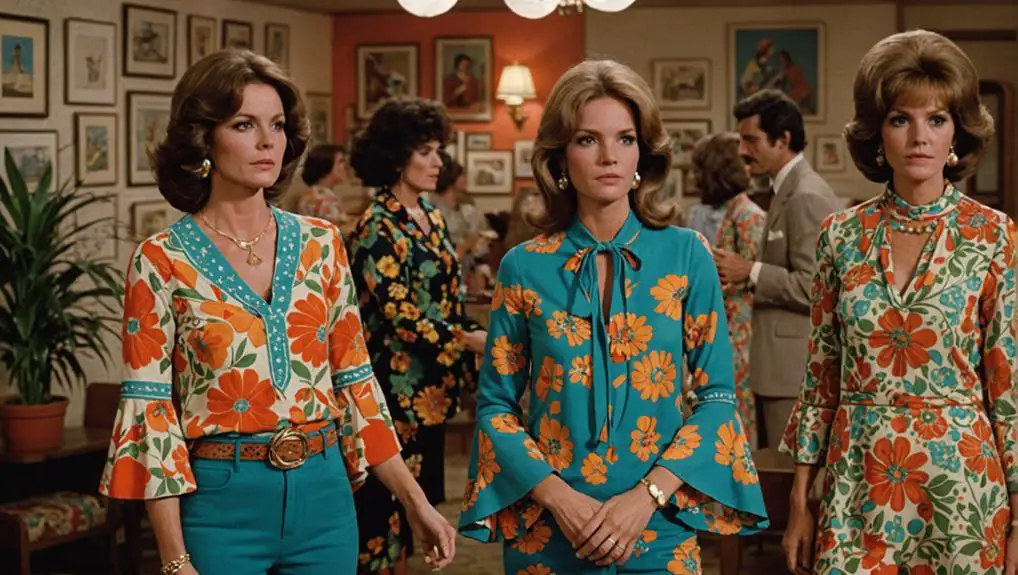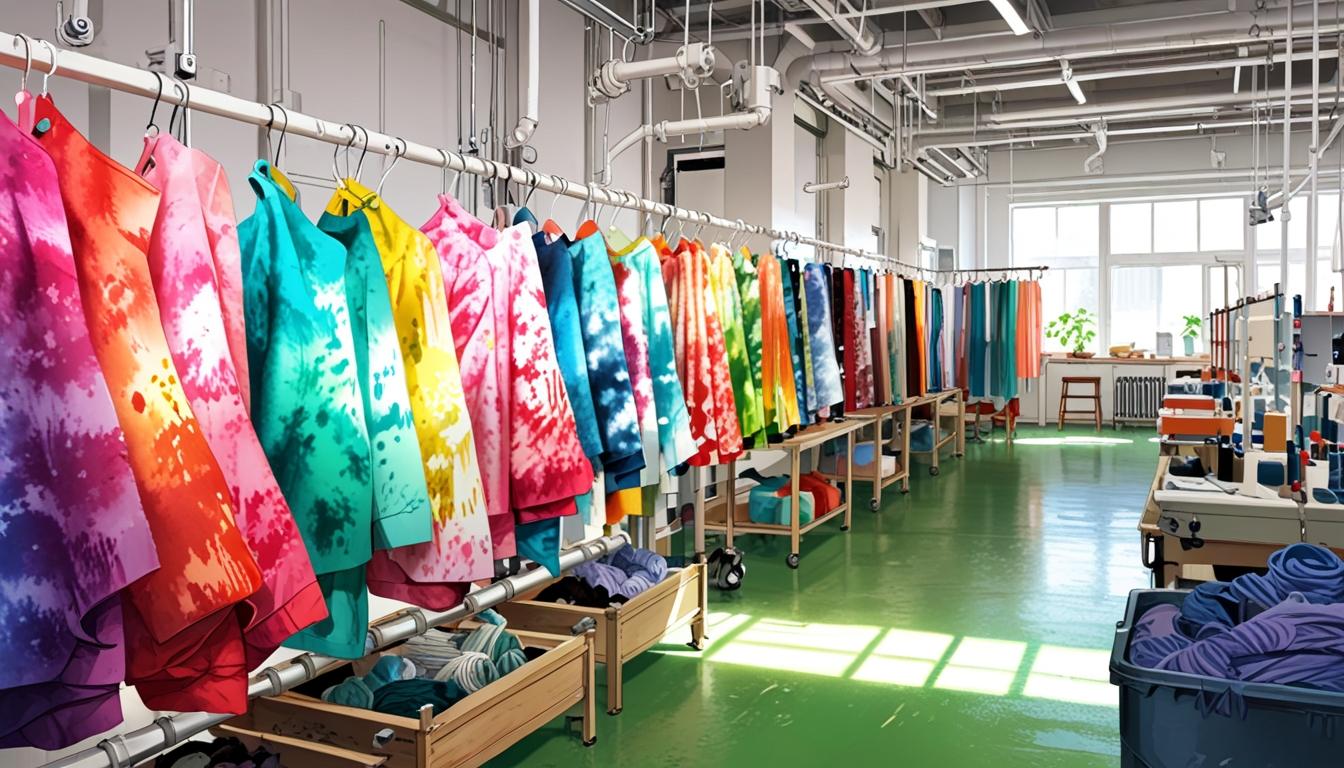In the 1970s, women's blouses captured a spirit of freedom and creativity. You'd encounter flowing fabrics adorned with vibrant paisley and psychedelic tie-dye patterns, reflecting the bohemian influence of the time. Styles like silk pussy bow blouses and off-the-shoulder cuts offered versatility for various occasions. The feminist movement empowered women to embrace diverse, practical clothing options. Brands like Fashionbilt made these expressive styles accessible. With unique elements like large collars and bell sleeves, these blouses highlighted cultural appreciation. Curious about how these trends shaped women's fashion further? There's much more to explore about this transformative decade.
Fashion Trends of the 1970s

The 1970s truly marked a turning point in women's fashion, where styles broke away from traditional norms and embraced a more liberated spirit. This era embraced bohemian and gypsy influences, leading to the rise of flowing fabrics and vibrant patterns. One standout piece was the boho top, often adorned with floral printed designs that captured the essence of the decade's counterculture. These tops offered a relaxed fit, perfectly complementing the maxi skirts that became a staple in 1973. During this time, vintage clothing labels like Fashionbilt became synonymous with affordable yet stylish women's wear, showcasing bold colors and patterns typical of the era.
You'd notice that women's blouses during this time featured bold graphics, paisley patterns, and tie-dye designs, reflecting the influence of rock music and youth culture. The eclectic mix of colors and styles spoke volumes about the social changes occurring, showcasing a newfound freedom in self-expression.
Ethnic-inspired patterns and peasant blouses were widely embraced, adding to the rich tapestry of fashion trends. Large collars and unique fabric combinations, like polyester and chiffon, shaped the look, influenced by iconic figures of the time. As you navigate through the 1970s, you'll see how these fashion trends were not just clothing; they were a declaration of individuality and a reflection of the cultural shifts defining the era.
Iconic Fashion Figures
As the 1970s embraced a spirit of individuality and freedom in fashion, iconic figures emerged who not only showcased the era's distinctive blouses but also influenced its evolving trends. Prominent models like Christie Brinkley epitomized the boho hippie aesthetic, making tops for women synonymous with bold patterns and vibrant colors. Her influence helped popularize the fluid silhouettes and eclectic designs that characterized the decade, reflecting the growing emphasis on vintage tag identification to understand the provenance and value of these unique garments.
Photographers like Bert Stern captured the essence of these styles in Vogue, immortalizing the playful yet sophisticated looks of the time. The interplay of classic elegance from stars like Audrey Hepburn and Marilyn Monroe with contemporary designs created a unique fusion that defined 1970s blouses. Designers such as Halston and Yves Saint Laurent were pivotal, introducing innovative fabrics and cuts that transformed women's fashion.
Today, fashion bloggers and influencers often reference these 1970s icons, driving a resurgence of vintage blouse styles. Their impact on modern trends is undeniable, as you continue to see the bohemian influence reflected in contemporary fashion. The legacy of these fashion figures not only shaped their time but also remains relevant, inspiring new generations to embrace the spirit of the 1970s.
Distinctive Clothing Items
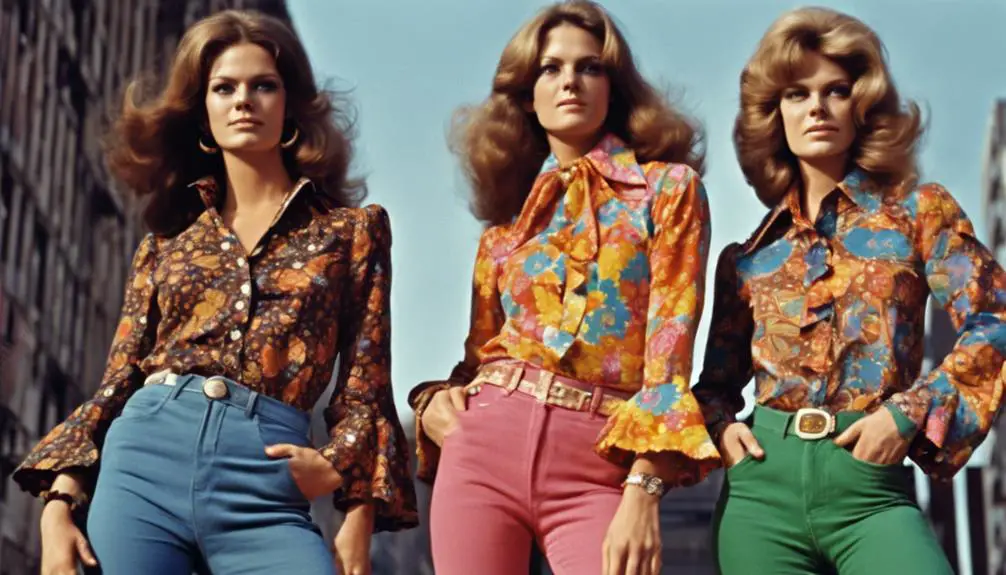
Embracing bold patterns and vibrant colors, 1970s blouses offered a distinctive blend of style and comfort that defined the decade. The eclectic nature of this era manifested in various unique clothing items, making it easy for you to express individuality through fashion.
Key features of 1970s blouses included:
- Tie-Dye Patterns: Capturing the psychedelic spirit, these eye-catching designs became a staple for youth culture.
- Ethnic Peasant Styles: Popularized by the hippie movement, these blouses featured intricate embroidery and flowing fabrics for a bohemian feel.
- Silk Pussy Bow Blouses: Merging elegance with comfort, these versatile blouses were perfect for both office and casual settings.
- Large Collars and Ruffles: These distinctive styling elements added flair and femininity to your outfits.
- Long Bell Sleeves and Off-the-Shoulder Cuts: These designs provided options for both casual and dressy occasions, enhancing your wardrobe versatility.
The 1970s blouses reflected a free-spirited approach to fashion, allowing you to embrace creativity while enjoying the comfort and style that defined the decade.
Cultural Influences on Fashion
Cultural influences in the 1970s played a pivotal role in shaping women's fashion, particularly blouses. The rise of counterculture movements brought bohemian and hippie styles to the forefront, encouraging you to embrace vibrant prints and relaxed fits. Music festivals like Woodstock popularized ethnic prints and casual styles, making peasant blouses and tunic tops essential items in your wardrobe.
The feminist movement also greatly impacted fashion choices, empowering you to opt for diverse and practical clothing options. This led to a surge in the popularity of comfortable yet stylish blouses, such as sleeve blouses that combined elegance with ease.
Television and film further influenced trends, showcasing strong female characters adorned in colorful, bold designs that mirrored the shifting social norms of the time. The integration of various ethnic influences resulted in unique textiles and patterns, highlighting a growing appreciation for cultural expression in women's fashion. As you explored these influences, you found that the 1970s blouses weren't just clothing; they were statements of identity, freedom, and a reflection of a dynamic cultural landscape that invited you to express yourself unapologetically.
Styles of 70s Shirts
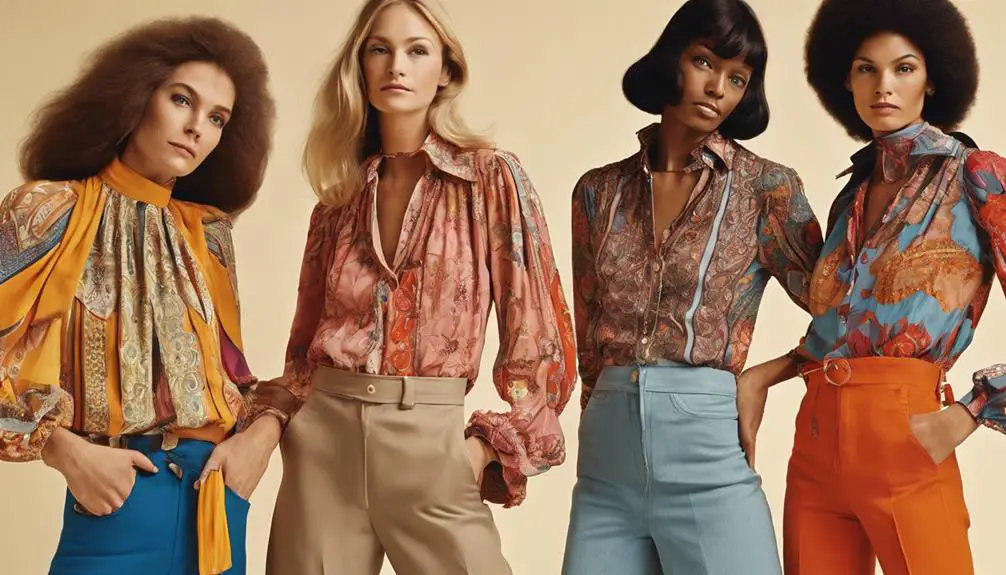
The vibrant cultural shifts of the 1970s directly influenced the styles of shirts that became popular during the decade. You'd find a diverse array of designs that catered to both casual and formal settings, highlighting women's evolving roles in society. Here's a glimpse into the styles that defined the era:
- Silk pussy bow blouses: These long sleeve, button front shirts combined femininity with professionalism, making them a staple for office wear.
- Pullover tunic tops with belts: Favored for home, these tops emphasized comfort with their relaxed fits.
- Large collars: A distinctive feature of button-down and knit polo shirts, contributing to the bold aesthetic of the time.
- Smock tops and peasant shirts: These loose-fitting designs, often with colorful patterns, embodied a carefree spirit influenced by the broader cultural movements.
- Disco attire: Late 70s nightlife saw the rise of eye-catching sequin shirts and gold metallic halternecks, reflecting the vibrancy of the era's social scene.
These styles not only represented fashion trends but also mirrored the dynamic changes in women's lives and identities during the decade.
Hippie Fashion
Hippie fashion in the 1970s marked a significant departure from mainstream styles, reflecting a deeper connection to individualism and global influences. You'll find that short sleeve blouses, often crafted from natural fibers like cotton and linen, became staples of the hippie wardrobe. These materials offered comfort and breathability, perfect for the era's laid-back lifestyle. Ethnic peasant blouses, richly embellished with colorful embroidery, showcased a vibrant aesthetic that embraced global cultures, similar to the styles seen in vintage collections by brands like Betty Barclay.
Tie-dye patterns emerged as a hallmark of this movement, with swirling designs and bold colors symbolizing peace and love. Pairing these blouses with fringe vests or halter necks created quintessential hippie looks, embodying a free-spirited essence. Accessories played a vital role, too—headbands, oversized earrings, and layered necklaces complemented your blouse, enhancing that bohemian vibe.
The essence of hippie fashion lies in its rebellious spirit and eclectic style. When you wear a short sleeve blouse adorned with tie-dye or floral prints, you're not just making a fashion statement; you're connecting with a cultural movement that celebrated individuality, comfort, and a shared vision of harmony.
Casual and Boho Styles
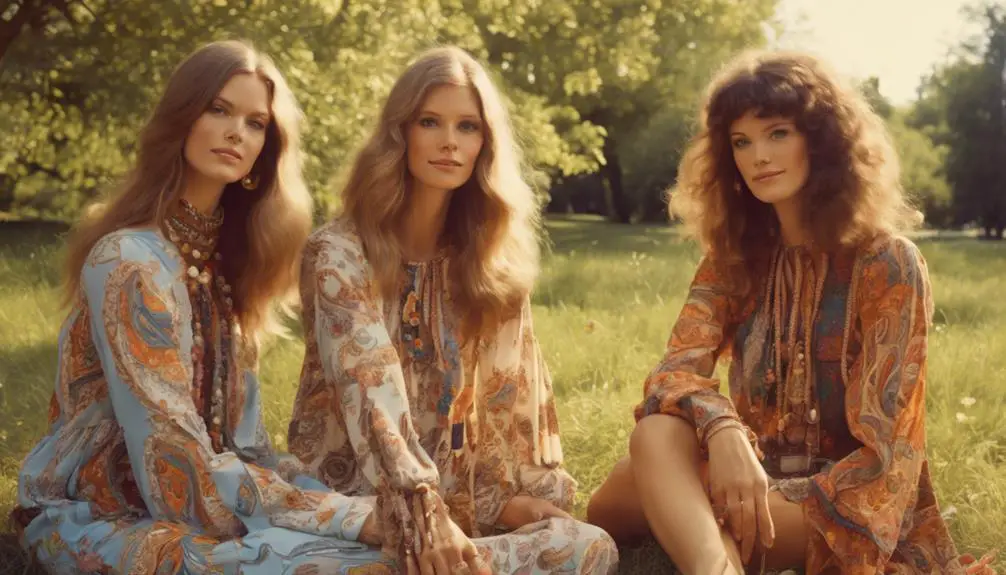
Casual and boho styles in the 1970s offered an invigorating blend of comfort and creativity, allowing individuals to express their unique identities through fashion. Women casual tops featured lightweight materials like chiffon, adorned with floral patterns that captured the free-spirited essence of the decade. Long bell sleeve tops gained popularity for their relaxed fit, becoming staples paired with high-waisted jeans or flowing maxi skirts. This laid-back aesthetic was perfect for everyday wear.
Key elements of casual and boho styles included:
- Lightweight chiffon floral blouses that celebrated femininity and comfort.
- Long bell sleeve tops that added a relaxed vibe to any outfit.
- Tunic tops with sequin overlays, combining casual comfort with understated glamour.
- Colorful tie-dye patterns that reflected the vibrant spirit of the hippie movement.
- Crochet and tassel vests that enhanced layering options and provided texture.
These tops not only defined an era but also allowed women to embrace their individuality, making bold fashion statements while enjoying the comfort and freedom that characterized the 1970s.
Athletic and Leisure Wear
Comfort and versatility defined the evolution of athletic and leisure wear in the 1970s, as the decade witnessed a burgeoning fitness culture. You likely noticed how striped knit crop tops emerged as a staple, seamlessly shifting from gym sessions to casual outings. These tops not only provided ease of movement but also embraced the decade's fashion ethos of mixing functionality with style.
Ringer t-shirts, adorned with humorous sayings and vibrant graphics, quickly became a canvas for self-expression among younger demographics. You could easily spot these playful tees at social gatherings, reflecting the carefree spirit of the era. Furthermore, graphic tees featuring desert and nature themes catered to a growing demand for leisurewear that wasn't just practical but also visually appealing.
The overall trend leaned heavily towards comfort, with many pieces designed for relaxation and casual social activities. This blend of fashion and functionality resonated with the free-spirited nature of 1970s fashion, allowing you to enjoy your active lifestyle without sacrificing style. In this way, athletic and leisure wear during the 1970s not only represented a shift in clothing but also mirrored a cultural transformation towards health and well-being.
Notable Brands and Prices

As the 1970s unfolded, women's blouses became a significant part of the fashion landscape, reflecting both the era's cultural shifts and evolving consumer preferences. Notable brands emerged, each offering unique styles and varying price points that catered to the diverse tastes of women.
Here are some key players in the market:
- ModCloth: Known for 70s-inspired button-up tops, these blouses were priced around $54, appealing to those wanting a touch of nostalgia.
- Verdusa: Featuring stylish options, blouses started at $34, making them accessible to a wider audience.
- Fun World: Specializing in themed hippie costumes, prices varied based on design complexity, perfect for parties and events.
- Aura Slow Mornings: Showcasing unique multi-print designs, their tops reflected the eclectic styles popular during the decade.
- KlumKool: Offering competitively priced Dashiki shirts, they represented the tribal and boho aesthetics gaining traction.
Additionally, Aboser's vintage tunic tops began at just $11.28, emphasizing affordability for those exploring retro neck top styles. These brands highlight the rich tapestry of fashion that defined women's blouses in the vibrant 1970s.
Frequently Asked Questions
What Materials Were Commonly Used in 1970S Blouses?
In the 1970s, you'd find blouses made from lightweight fabrics like polyester, cotton, and silk. These materials offered breathability and comfort, reflecting the vibrant styles and cultural shifts that defined that dynamic decade.
How Did Blouses Reflect the Feminist Movement of the 1970s?
Blouses mirrored the feminist movement by embracing empowerment through bold styles and comfortable fits. You'd notice women choosing designs that challenged norms, promoting individuality and asserting their presence in both the workplace and society at large.
What Were Popular Colors for Women's Blouses in the 1970s?
In the 1970s, you'd notice vibrant colors like orange, mustard, and teal dominating fashion. These hues reflected a bold, expressive style, allowing you to embrace individuality while also resonating with the decade's cultural shifts.
How Did Blouses Differ Between Various Social Classes in the 1970s?
Blouses often reflected social class differences, with higher classes favoring luxurious fabrics and tailored designs, while lower classes embraced more affordable, simpler styles. You'd notice these contrasts in both materials and overall craftsmanship.
What Care Instructions Were Recommended for 1970S Polyester Blouses?
When caring for polyester blouses, you'd typically wash them in cold water, avoid bleach, and tumble dry on low. Ironing's often unnecessary, but if needed, use a low heat setting to prevent damage.
